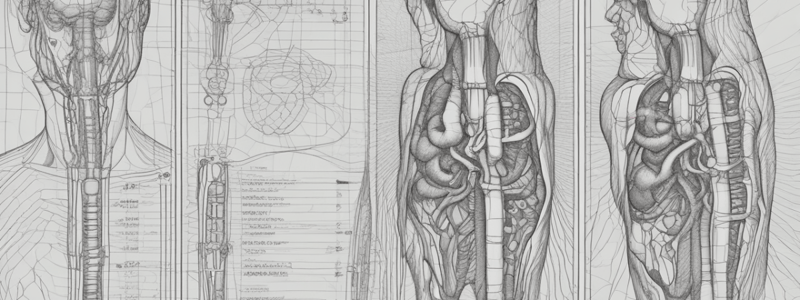Podcast
Questions and Answers
Who should review a patient's medical history before administering contrast agents?
Who should review a patient's medical history before administering contrast agents?
- The caregiver
- The physician (correct)
- The technologist
- The patient
What is necessary before contrast administration?
What is necessary before contrast administration?
- Patient history review
- Patient monitoring
- Patient education (correct)
- Patient preparation
What may be included in patient preparation before administering oral contrast agents?
What may be included in patient preparation before administering oral contrast agents?
- Decreased sleep
- Increased exercise
- Restricted diet (correct)
- Increased water intake
What is important in the proper preparation of contrast media?
What is important in the proper preparation of contrast media?
What is required for contrast administration by power/pressure injector?
What is required for contrast administration by power/pressure injector?
What should be done in case of adverse reactions to contrast media?
What should be done in case of adverse reactions to contrast media?
What is NSF and who is at risk?
What is NSF and who is at risk?
What do ACR Guidelines provide information on?
What do ACR Guidelines provide information on?
What is a black box warning?
What is a black box warning?
What are the emergency procedures for anaphylactic shock?
What are the emergency procedures for anaphylactic shock?
Who should review a patient's medical history before administering contrast agents?
Who should review a patient's medical history before administering contrast agents?
What is necessary before contrast administration?
What is necessary before contrast administration?
What may be included in patient preparation before administering oral contrast agents?
What may be included in patient preparation before administering oral contrast agents?
What is important in the proper preparation of contrast media?
What is important in the proper preparation of contrast media?
What is required for contrast administration by power/pressure injector?
What is required for contrast administration by power/pressure injector?
What should be done in case of adverse reactions to contrast media?
What should be done in case of adverse reactions to contrast media?
What is NSF and who is at risk?
What is NSF and who is at risk?
What do ACR Guidelines provide information on?
What do ACR Guidelines provide information on?
What is a black box warning?
What is a black box warning?
What are the emergency procedures for anaphylactic shock?
What are the emergency procedures for anaphylactic shock?
What is the main purpose of palpation during vein selection for venipuncture?
What is the main purpose of palpation during vein selection for venipuncture?
What is the most suitable vein for venipuncture?
What is the most suitable vein for venipuncture?
What should be avoided when choosing a venipuncture site?
What should be avoided when choosing a venipuncture site?
What is the recommended angle for inserting the needle during venipuncture?
What is the recommended angle for inserting the needle during venipuncture?
What is the purpose of applying a tourniquet during venipuncture?
What is the purpose of applying a tourniquet during venipuncture?
What is the proper technique for cleansing the patient's arm before venipuncture?
What is the proper technique for cleansing the patient's arm before venipuncture?
What is the recommended wait time before reapplying a tourniquet during venipuncture?
What is the recommended wait time before reapplying a tourniquet during venipuncture?
What should be done if infiltration/extravasation is detected during venipuncture?
What should be done if infiltration/extravasation is detected during venipuncture?
Who is allowed to perform venipuncture on patients in California?
Who is allowed to perform venipuncture on patients in California?
What is the main purpose of applying pressure to the gauze after removing the needle during venipuncture?
What is the main purpose of applying pressure to the gauze after removing the needle during venipuncture?
What are the three main types of blood vessels?
What are the three main types of blood vessels?
Which blood vessels are used for venipuncture?
Which blood vessels are used for venipuncture?
What should be avoided when selecting a vein for venipuncture?
What should be avoided when selecting a vein for venipuncture?
What factors influence vein selection for venipuncture?
What factors influence vein selection for venipuncture?
What are some techniques for improving venous access?
What are some techniques for improving venous access?
Who is allowed to perform venipuncture?
Who is allowed to perform venipuncture?
Which veins are used most frequently for venipuncture?
Which veins are used most frequently for venipuncture?
Why should foot veins be avoided for venipuncture?
Why should foot veins be avoided for venipuncture?
What areas should be avoided when choosing a site for venipuncture?
What areas should be avoided when choosing a site for venipuncture?
What is the procedure for vein selection and venipuncture?
What is the procedure for vein selection and venipuncture?
What are the three types of blood vessels?
What are the three types of blood vessels?
What type of blood vessel is used for venipuncture?
What type of blood vessel is used for venipuncture?
What helps blood flow in veins?
What helps blood flow in veins?
How should the most suitable vein for venipuncture be evaluated?
How should the most suitable vein for venipuncture be evaluated?
What factors influence vein selection for venipuncture?
What factors influence vein selection for venipuncture?
Which techniques can be used to improve venous access?
Which techniques can be used to improve venous access?
Are students in California allowed to perform venipuncture on patients?
Are students in California allowed to perform venipuncture on patients?
Who is permitted to perform venipuncture to inject contrast material?
Who is permitted to perform venipuncture to inject contrast material?
Which veins are used most frequently for venipuncture?
Which veins are used most frequently for venipuncture?
What should be avoided when choosing a site for venipuncture?
What should be avoided when choosing a site for venipuncture?
Flashcards are hidden until you start studying
Study Notes
Guidelines for Administering Contrast Agents in Medical Imaging
- Patient history should be reviewed before administering contrast agents to avoid risk, especially in patients with sickle cell anemia, severe asthma, drug allergy, adverse reaction to contrast media, or impaired kidney function.
- Patient education is necessary before contrast administration, and technologists should provide information to patients and caregivers to improve treatment outcomes.
- Patient preparation may include a restricted diet and bowel preparation before administering oral contrast agents.
- Proper preparation of contrast media includes using the correct dose based on patient weight and age, checking for expiration dates, and using aseptic technique.
- Contrast administration by hand requires careful attention to the puncture site, aspiration of a small amount of blood, and monitoring for extravasation.
- Contrast administration by power/pressure injector requires checking the integrity of venous access, matching the gauge of the angiocatheter with the rate of contrast media flow, flushing the catheter and tubing with sterile saline solution, and avoiding alternative access sites.
- Adverse reactions to contrast media may be local or systemic, and require immediate action including stopping contrast administration, cold compress, medication, and follow-up care.
- Contrast reactions can range from mild to severe, and severe reactions can be life-threatening, requiring emergency care.
- Emergency procedures for anaphylactic shock include seeking immediate help, injecting epinephrine into the outer muscle of the thigh, administering oxygen and IV antihistamines and cortisone, and performing CPR if necessary.
- NSF (Nephrogenic Systemic Fibrosis) is a rare but serious condition associated with the use of gadolinium-based contrast agents in patients with renal disease, hypertension, or diabetes.
- ACR Guidelines on renal function and dialysis provide detailed information on the risk factors for NSF.
- The FDA requires a black box warning on the labeling of prescription drugs or drug products associated with serious hazards, including contrast agents.
Guidelines for Administering Contrast Agents in Medical Imaging
- Patient history should be reviewed before administering contrast agents to avoid risk, especially in patients with sickle cell anemia, severe asthma, drug allergy, adverse reaction to contrast media, or impaired kidney function.
- Patient education is necessary before contrast administration, and technologists should provide information to patients and caregivers to improve treatment outcomes.
- Patient preparation may include a restricted diet and bowel preparation before administering oral contrast agents.
- Proper preparation of contrast media includes using the correct dose based on patient weight and age, checking for expiration dates, and using aseptic technique.
- Contrast administration by hand requires careful attention to the puncture site, aspiration of a small amount of blood, and monitoring for extravasation.
- Contrast administration by power/pressure injector requires checking the integrity of venous access, matching the gauge of the angiocatheter with the rate of contrast media flow, flushing the catheter and tubing with sterile saline solution, and avoiding alternative access sites.
- Adverse reactions to contrast media may be local or systemic, and require immediate action including stopping contrast administration, cold compress, medication, and follow-up care.
- Contrast reactions can range from mild to severe, and severe reactions can be life-threatening, requiring emergency care.
- Emergency procedures for anaphylactic shock include seeking immediate help, injecting epinephrine into the outer muscle of the thigh, administering oxygen and IV antihistamines and cortisone, and performing CPR if necessary.
- NSF (Nephrogenic Systemic Fibrosis) is a rare but serious condition associated with the use of gadolinium-based contrast agents in patients with renal disease, hypertension, or diabetes.
- ACR Guidelines on renal function and dialysis provide detailed information on the risk factors for NSF.
- The FDA requires a black box warning on the labeling of prescription drugs or drug products associated with serious hazards, including contrast agents.
Venipuncture: Types of Blood Vessels, Choosing a Suitable Vein, and Procedure
- There are three types of blood vessels: veins, arteries, and capillaries.
- Venipuncture is performed only on veins.
- Veins have valves that open and close with muscle contraction to help blood flow.
- The most suitable vein for venipuncture should be evaluated through palpation and visual inspection.
- Veins near sites of infection, bruising, phlebitis, edematous tissue, and previous venipuncture should be avoided.
- Age, weight, medications, temperature, and patient anxiety are factors that influence vein selection for venipuncture.
- Techniques to improve venous access include applying a tourniquet, opening and closing the fist, lowering the arm below heart level, and light tapping of the vein.
- Students in California are not allowed to perform venipuncture on patients, but they can observe and learn during clinical externship.
- Venipuncture to inject contrast material is permitted for certified radiologic technologists who have completed an approved training course.
- The larger and fuller median cubital and cephalic veins of the arm are used most frequently, but the basilic vein on the dorsum of the arm or dorsal hand veins are also acceptable for venipuncture.
- Areas to be avoided when choosing a site include extensive scars, hematoma, edematous extremities, and sites where venipuncture has been recently performed.
- The procedure for venipuncture includes identifying the patient correctly, verifying their condition, applying a tourniquet, selecting the venipuncture site, preparing the patient's arm, inserting the needle, removing the tourniquet, checking for infiltration/extravasation, removing the needle, and pressing down on the gauze.
Studying That Suits You
Use AI to generate personalized quizzes and flashcards to suit your learning preferences.




